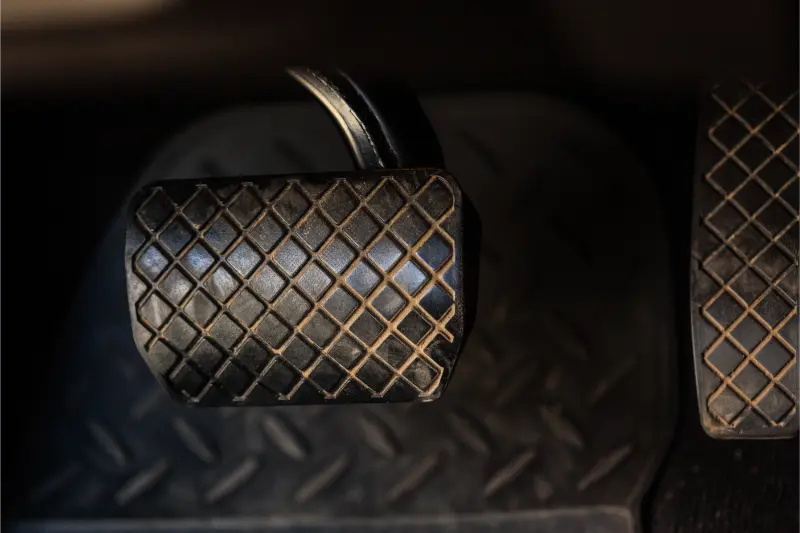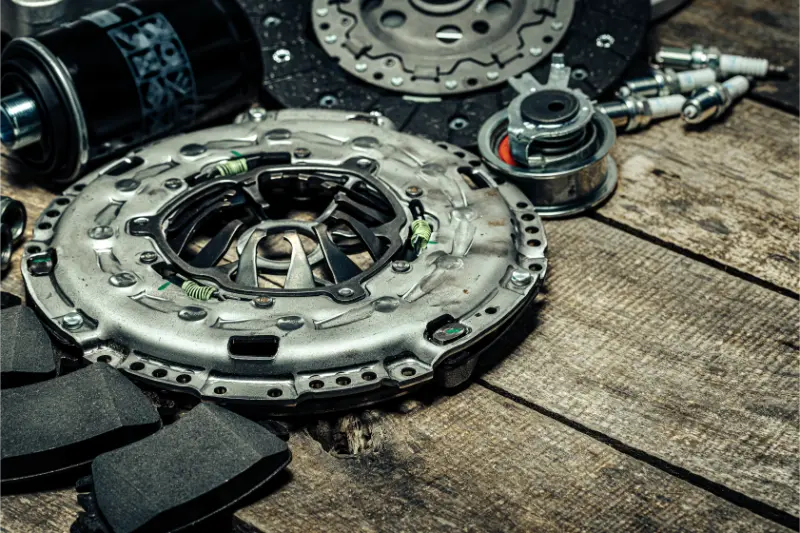Knowing when to replace a clutch is key to ensuring uninterrupted performance and longevity for your manual transmission vehicle. Within this guide, we unpack the signs of clutch wear – from gear shift challenges to unexpected noises – and showcase how to extend your clutch’s lifespan. Stay with us to navigate the essentials of clutch maintenance and spot “when to replace a clutch” cues like a pro.

Key Takeaways
- Clutch problems, such as grinding noises, gear shifting difficulties, poor acceleration, and gear slippage, indicate the need for an inspection and potential repair to prevent costly damages.
- A clutch’s lifespan, ranging from 30,000 to 100,000 miles based on driving habits and maintenance practices, can be extended by avoiding habits like riding the clutch and ensuring smooth gear changes.
- Ivydene Garage Ltd. offers comprehensive clutch services backed by over 30 years of experience and recognition as a Bosch Center of Excellence, providing expert advice and professional automotive solutions for various vehicle makes and models.
Understanding the Clutch System
The clutch system in a manual transmission vehicle serves as the critical link between the engine and the wheels. It allows for the separation of the engine from the wheels during gear changes and complete stops while the engine is still running. The clutch system includes the clutch disc, pressure plate, and flywheel, which work together to transmit power from the engine to the wheels smoothly.
A properly functioning clutch is vital for a vehicle to start from a standstill, accelerate, decelerate, and shift gears without damaging the engine or transmission.
How the Clutch Works
When you press the spongy clutch pedal, the clutch disc, clutch plate, and pressure plate disengage, interrupting the power flow from the engine to the transmission. This disengagement allows you to change gears without damaging the gearbox.
When you release the clutch pedal, the release bearing disengages the disc and pressure plate, transmitting power from the engine to the wheels again. This mechanism of engaging and disengaging enables the seamless gear changes and smooth acceleration you experience when driving a manual transmission vehicle.
Types of Clutches
There’s more than one type of clutch, and the one used in your vehicle can depend on various factors, including your vehicle’s performance characteristics and driving needs. For instance, performance vehicles often use a Direct-Shift Gearbox (DSG) – a dual-clutch system that combines the efficiency of a manual transmission with the convenience of an automatic one.
DSG systems offer quick and fluid gear changes, which are crucial for efficient power delivery in performance vehicles.
Identifying Clutch Problems
Detecting clutch problems early can prevent more serious issues and save you from costly repairs. Symptoms of clutch issues can include:
- Grinding, squeaking, or grumbling noises when you press the clutch pedal
- Difficulties in shifting gears
- There is a sense of poor acceleration despite a revving engine
- Gear slippage
If you notice any of these symptoms, it is essential to have your clutch inspected and repaired as soon as possible.
If your clutch pedal remains stuck to the floor or does not return to its normal position, it may be loose. This situation signals severe issues that require immediate attention.
Clutch Slippage
One common clutch problem is a slipping clutch, which occurs when the engine revs but the car doesn’t accelerate. This issue could manifest as excessive engine revving when attempting to accelerate without a corresponding increase in vehicle speed. The worn-out friction material on the clutch disc often hampers its ability to effectively hold and transmit the engine’s power to the drivetrain, resulting in clutch slippage.
Gear Shifting Issues
Issues with gear shifting can signal problems with the clutch system. If you hear grinding noises when shifting gears, it’s a sign that the clutch is not fully disengaging. If not addressed promptly, this improper disengagement could lead to transmission damage.
Difficulty shifting gears can also indicate gearbox issues related to the clutch system.
Factors Affecting Clutch Lifespan
Several factors can affect the lifespan of your clutch. These factors include:
- Driving habits
- Traffic conditions
- The type of vehicle you drive
- Your maintenance practices
Aggressive driving, frequent stop-and-go traffic, and heavy towing can accelerate clutch wear.
The type of vehicle you drive and how well you adhere to regular maintenance routines can also significantly impact your clutch’s longevity.
Driving Habits
Your driving habits can significantly influence the lifespan of your clutch. Aggressive driving with sudden starts and abrupt stops puts extra strain on the clutch, reducing its durability. Similarly, towing heavy loads can stress the clutch, leading to accelerated wear and a shortened lifespan.
Even something as simple as keeping your foot on the clutch pedal when not actively changing gears can cause extra friction and wear.
Maintenance Practices
Proper maintenance practices can help prolong the lifespan of your clutch. Frequent maintenance checks and timely part replacements can significantly extend the service life of your clutch.
Regular vehicle maintenance, such as changing the oil, replacing transmission fluids and filters approximately every 40,000 to 60,000 kilometres, and maintaining proper fluid levels, is essential for clutch longevity.
When to Replace Your Clutch
Knowing when to replace your clutch is crucial for maintaining optimal vehicle performance. The average lifespan of a clutch system is typically around 60,000 miles, with replacements commonly required after 50,000 to 100,000 miles of driving. However, this can vary based on various factors, including driving habits and maintenance practices. Recognising the signs that your clutch needs replacing can help avoid potential issues.
It’s important to promptly replace your clutch when worn, as there are usually no specific warning lights for clutch issues.
Mileage Considerations
The typical lifespan of a clutch in a manual transmission vehicle ranges from 30,000 to 100,000 miles, depending on various factors. Driving conditions and habits significantly influence clutch lifespan, with some drivers needing to replace their clutch well before reaching the 30,000-mile mark. In contrast, others may not require a replacement until surpassing 100,000 miles.
Expert Recommendations
When dealing with clutch problems, it’s always best to seek professional advice. At Ivydene Garage Ltd., we offer expert advice and professional clutch services for various vehicle makes and models. With over 30 years of experience, we have access to the latest diagnostic tools from Bosch and can provide you with the best solutions for your clutch issues.
Clutch Replacement Process
Replacing a clutch is a complex process that involves several steps:
- Securely park the car and prepare the transaxle for removal.
- Unbolt the engine mount.
- Replace the clutch components.
- Reattach the transaxle, ensuring all pipes, wires, and the gear selector linkage connect correctly.
This process typically requires two to six hours, depending on the vehicle’s make and model.
Preparing for Replacement
Before starting the clutch replacement process, preparing your vehicle is essential. This preparation includes:
- Raising the front end of the car using a high-quality jack
- Ensuring the engine and transmission are stable
- Unhooking the clutch and battery cables
- Disconnecting electrical connections and the speedometer cable
Installing the New Clutch
Installing a new clutch involves the following steps:
- Clean the crankshaft flange and any other removed parts to ensure they are free of contaminants before fitting the new components.
- Install a new flywheel, if necessary.
- Position the clutch disc using an alignment tool to ensure accurate placement.
- Secure the pressure plate.
After installing the clutch components, refit the transaxle, ensuring you correctly reconnect all pipes, wires, and the gear selector linkage using a transmission jack.

Tips for Prolonging Clutch Life
Proper usage and maintenance can significantly prolong the lifespan of your clutch system. Here are some tips to help reduce wear and tear on your clutch:
- Avoid habitual riding of the clutch and execute timely gear shifts.
- Shift into neutral when the vehicle is stopped or idle.
- Use the parking brake or handbrake instead of the clutch to hold the car when stationary.
Following these tips can help minimise wear on your clutch and extend its lifespan, potentially reducing the need for clutch repair and avoiding a worn clutch.
Avoid Riding the Clutch
One of the most important tips for prolonging clutch life is to avoid riding the clutch. Resting your foot on the clutch pedal, even lightly, can lead to premature wear. Similarly, changing gears before fully depressing the pedal can accelerate clutch wear.
It’s also important to keep your foot off the clutch when accelerating to prevent prematurely burning it out.
Smooth Gear Changes
Smooth gear changes can also help prolong your clutch’s lifespan. Fully disengaging the clutch before changing gears can prevent premature wear of the transmission components. Similarly, shifting gears without fully disengaging the clutch can lead to difficulty in gear selection and potential damage to the gearbox.
Proper fluid levels and hydraulic system integrity are essential for seamless vehicle gear changes with a hydraulic clutch system.
Ivydene Garage Ltd.’s Clutch Services
At Ivydene Garage Ltd., we specialise in providing professional clutch services for various vehicle makes and models. Recognised by Bosch as a centre of excellence for over 32 years, we deliver expert service backed by years of experience and the latest diagnostic tools.
Bosch Center of Excellence
Being recognised as a Bosch Center of Excellence is a testament to our commitment to delivering high-quality automotive solutions. For over three decades, we have been a Bosch agent, equipped to handle the latest automotive technology in vehicles of all makes.
This long-term commitment to excellence underscores our dedication to consistently providing professional and efficient automotive solutions over the years.
Comprehensive Service Offerings
Our comprehensive suite of automotive services includes:
- MOT tests
- Engine diagnostics
- Car servicing
- Comprehensive clutch replacements
- Tyre and wheel services
- Air conditioning services
We offer a one-stop solution for all your vehicle needs.
Summary
In conclusion, understanding the clutch system, recognising the signs of clutch problems, and knowing when to replace your clutch are crucial for maintaining your vehicle’s performance and longevity. Regular maintenance, good driving habits, and timely clutch replacements can significantly prolong your clutch’s lifespan and prevent costly repairs. At Ivydene Garage Ltd., we are committed to providing expert clutch services and comprehensive automotive solutions to meet your vehicle’s needs.
Frequently Asked Questions
What is the function of the clutch in a manual transmission vehicle?
The clutch in a manual transmission vehicle allows the engine to be separated from the wheels during gear changes and stops, serving as a critical link between the two.
What are the signs of clutch problems?
If you notice grinding, squeaking, or grumbling noises when pressing the clutch pedal, difficulties in shifting gears, poor acceleration despite a revving engine, or gear slippage, these could be signs of clutch problems. It’s important to have your vehicle inspected for potential issues.
How can I prolong the lifespan of my clutch?
To prolong the lifespan of your clutch, ensure proper usage by avoiding riding the clutch, executing timely gear shifts, and maintaining proper fluid levels. Following these steps will help reduce wear and tear on the clutch.
When should I replace my clutch?
You should consider replacing your clutch system after 50,000 to 100,000 miles of driving, although your driving habits and maintenance routines can influence the specific lifespan.
What services does Ivydene Garage Ltd. offer?
Ivydene Garage Ltd. offers a comprehensive suite of automotive services, including MOT tests, engine diagnostics, car servicing, clutch replacements, tyre and wheel services, and air conditioning services. They can also handle various vehicle maintenance and repair needs.
